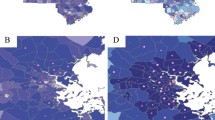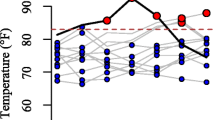Abstract
Heat stress illnesses represent a rising public health threat; however, associations between environmental heat and observed adverse health outcomes across populations and geographies remain insufficiently elucidated to evaluate risk and develop prevention strategies. In particular, military-relevant large-scale studies of daily heat stress morbidity responses among physically active, working-age adults to various indices of heat have been limited. We evaluated daily means, maximums, minimums, and early morning measures of temperature, heat index, and wet bulb globe temperature (WBGT) indices, assessing their association with 31,642 case-definition heat stroke and heat exhaustion encounters among active duty servicemembers diagnosed at 24 continental US installations from 1998 to 2019. We utilized anonymized encounter data consisting of hospitalizations, ambulatory (out-patient) visits, and reportable events to define heat stress illness cases and select the 24 installations with the highest case counts. We derived daily indices of heat from hourly-scale gridded climate data and applied a case-crossover study design incorporating distributed-lag, nonlinear models with 5 days of lag to estimate odds ratios at one-degree increments for each index of heat. All indices exhibited nonlinear odds ratios with short-term lag effects throughout observed temperature ranges. Responses were positive, monotonic, and exponential in nature, except for maximum daily WBGT, minimum daily temperature, temperature at 0600 h (local), and WBGT at 0600 h (local), which, while generally increasing, showed decreasing risk for the highest heat category days. The risk for a heat stress illness on a day with a maximum WBGT of 32.2 °C (90.0 °F) was 1.93 (95% CI, 1.82 – 2.05) times greater than on a day with a maximum WBGT of 28.6 °C (83.4 °F). The risk was 2.53 (2.36—2.71) times greater on days with a maximum heat index of 40.6 °C (105 °F) compared to 32.8 °C (91.0 °F). Our findings suggest that prevention efforts may benefit from including prior-day heat levels in risk assessments, from monitoring temperature and heat index in addition to WBGT, and by promoting control measures and awareness across all heat categories.




Similar content being viewed by others
Change history
21 April 2022
A Correction to this paper has been published: https://doi.org/10.1007/s00484-022-02291-5
References
Anderson GB, Bell ML, Peng RD (2013) Methods to calculate the heat index as an exposure metric in environmental health research. Environ Health Perspect 121:1111–1119. https://doi.org/10.1289/ehp.1206273
Armed Forces Health Surveillance Branch (2019) AFHSB surveillance case definitions: Heat Illness (MISC 20)
Armed Forces Health Surveillance Branch (2017) Defense medical epidemiology database (DMED) 5.0 Users Guide V. 1.0
Armed Forces Health Surveillance Branch (2020) Update: Heat illness, active component, U.S. Armed Forces, 2019. MSMR 27: 4–9
Becker RA, Chambers JM, Wilks AR (1988) The new S language: A programming environment for data analysis and graphics. 1st Edition. Chapman and Hall/CRC:Boca Raton
Budd GM (2008) Wet-bulb globe temperature (WBGT)—its history and its limitations. J Sci Med Sport 11:20–32. https://doi.org/10.1016/j.jsams.2007.07.003
Burkart K, Breitner S, Schneider A, Khan MdMH, Krämer A, Endlicher W (2014) An analysis of heat effects in different subpopulations of Bangladesh. Int J Biometeorol 58:227–237. https://doi.org/10.1007/s00484-013-0668-5
Carracedo-Martínez E, Taracido M, Tobias A, Saez M, Figueiras A (2010) Case-crossover analysis of air pollution health effects: a systematic review of methodology and application. Environ Health Perspect 118:1173–1182. https://doi.org/10.1289/ehp.0901485
Defense Medical Information System (DMIS) (2021) Defense medical information system (DMIS) identifier (ID) tables. Military Health System. Available: http://www.health.mil/Military-Health-Topics/Technology/Support-Areas/Geographic-Reference-Information/DMIS-ID-Tables. Accessed 12 Apr 2021
Gasparrini A, Armstrong B, Kenward MG (2010) Distributed lag non-linear models. Stat Med 29:2224–2234. https://doi.org/10.1002/sim.3940
Gasparrini A, Guo Y, Hashizume M, Kinney PL, Petkova LE et al (2015) Temporal variation in heat-mortality associations: A multicountry study. Environ Health Perspect 123:1200–1207. https://doi.org/10.1289/ehp.1409070
Golden JS, Hartz D, Brazel A, Luber G, Phelan P (2008) A biometeorology study of climate and heat-related morbidity in Phoenix from 2001 to 2006. Int J Biometeorol 52:471–480. https://doi.org/10.1007/s00484-007-0142-3
Grundstein A, Williams C, Phan M, Cooper E (2015) Regional heat safety thresholds for athletics in the contiguous United States. Appl Geogr 56:55–60. https://doi.org/10.1016/j.apgeog.2014.10.014
Guo Y, Gasparrini A, Armstrong BG, Tawatsupa B, Tobias Lavigne E et al (2017) Heat wave and mortality: A multicountry, multicommunity study. Environ Health Perspect 125:087006. https://doi.org/10.1289/EHP1026
Headquarters, Department of the Army and Air Force (2003) Heat stress control and heat casualty management (TB MED 507/AFPAM 48–152(I))
Kark JA, Burr PQ, Wenger CB, Gastaldo E, Gardner JW (1996) Exertional heat illness in marine corps recruit training. Aviat Space Environ Med 67:354–360
Keatinge WR, Coleshaw SR, Easton JC, Cotter F, Mattock MB, Chelliah R (1986) Increased platelet and red cell counts, blood viscosity, and plasma cholesterol levels during heat stress, and mortality from coronary and cerebral thrombosis. Am J Med 81:795–800. https://doi.org/10.1016/0002-9343(86)90348-7
Knowlton K, Rotkin-Ellman M, King G, Margolis HG, Smith SG et al (2009) The 2006 California heat wave: Impacts on hospitalizations and emergency department visits. Environ Health Perspect 117:61–67. https://doi.org/10.1289/ehp.11594
Lemke B, Kjellstrom T (2012) Calculating workplace wbgt from meteorological data: a tool for climate change assessment. Ind Health 50:267–278. https://doi.org/10.2486/indhealth.MS1352
Li S-Q, Li R-F, Xi S-M, Hu S, Jia Z-Q, Li S-P et al (2012) Systematical analysis of impacts of heat stress on the proliferation, apoptosis and metabolism of mouse hepatocyte. J Physiol Sci 62:29–43. https://doi.org/10.1007/s12576-011-0183-6
Lieblich M, Spector J (2017) wbgt: Wet bulb globe temperature. R package version 1.2
Liljegren JC, Carhart RA, Lawday P, Tschopp S, Sharp R (2008) Modeling the wet bulb globe temperature using standard meteorological measurements. J Occup Environ Hyg 5:645–655. https://doi.org/10.1080/15459620802310770
Lumley T, Levy D (2000) Bias in the case – crossover design: implications for studies of air pollution. Environmetrics 11:689–704. https://doi.org/10.1002/1099-095X(200011/12)11:6%3c689::AID-ENV439%3e3.0.CO;2-N
Maclure M (1991) The case-crossover design: a method for studying transient effects on the risk of acute events. Am J Epidemiol 133. https://doi.org/10.1093/oxfordjournals.aje.a115853
Macpherson RK (1962) The assessment of the thermal environment. A review. Br J Ind Med 19:151–164
Mathes RW, Ito K, Lane K, Matte TD (2017) Real-time surveillance of heat-related morbidity: Relation to excess mortality associated with extreme heat. PLOS ONE 12:e0184364. https://doi.org/10.1371/journal.pone.0184364
US Department of Defense (2020) Military Installations, Ranges, and Training Areas [Data file]. Retrieved from https://catalog.data.gov/dataset/military-installations-ranges-and-training-areas
Peel MC, Finlayson BL, McMahon TA (2007) Updated world map of the Köppen-Geiger climate classification. Hydrol Earth Syst Sci 11: 1633–1644. https://doi.org/10.5194/hess-11-1633-2007
QGIS Development Team (2021) QGIS Geographic information system. Open Source Geospatial Foundation
R Core Team (2020) R: A language and environment for statistical computing. R foundation for statistical computing:Vienna
Raymond C, Matthews T, Horton RM (2020) The emergence of heat and humidity too severe for human tolerance. Sci Adv 6:eaaw1838. https://doi.org/10.1126/sciadv.aaw1838
Schickele E (1947) Environment and fatal heat stroke: An analysis of 157 cases cccurring in the army in the U. S. during world war II. Mil Surg 100:235–256. https://doi.org/10.1093/milmed/100.3.235
Schober P, Boer C, Schwarte LA (2018) Correlation coefficients: Appropriate use and interpretation. Anesth Analg 126:1763–1768. https://doi.org/10.1213/ANE.0000000000002864
Stacey MJ, Parsons IT, Woods DR, Taylor PN, Ross D, Brett SJ (2015) Susceptibility to exertional heat illness and hospitalisation risk in UK military personnel. BMJ Open Sport Exerc Med 1:e000055. https://doi.org/10.1136/bmjsem-2015-000055
Tadić JM, Biraud SC (2020) Effects of climate change on precipitation and the maximum daily temperature (tmax) at two US military bases with different present-day climate. Climate 8:18. https://doi.org/10.3390/cli8020018
Therneau TM, Grambsch PM (2000) Modeling survival data: extending the Cox model. Springer, New York
Tong S, Wang XY, Guo Y (2012) Assessing the short-term effects of heatwaves on mortality and morbidity in brisbane, australia: comparison of case-crossover and time series analyses. PLOS ONE 7:e37500. https://doi.org/10.1371/journal.pone.0037500
United States Army Training and Doctrine Command (2016) TRADOC Regulation 350–29, Prevention of Heat and Cold Casualties
U.S. Global Change Research Program (2017) Climate science special report: Fourth national climate assessment, Volume I. U.S. Global Change Research Program, Washington
Weinberger KR, Harris D, Spangler KR, Zanobetti A, Wellenius GA (2020) Estimating the number of excess deaths attributable to heat in 297 United States counties. Environ Epidemiol 4. https://doi.org/10.1097/EE9.0000000000000096
Wilson TE, Cui J, Zhang R, Crandall CG (2006) Heat stress reduces cerebral blood velocity and markedly impairs orthostatic tolerance in humans. Am J Physiol Regul Integr Comp Physiol 291:R1443–R1448. https://doi.org/10.1152/ajpregu.00712.2005
Xia Y, Mitchell K, Ek M, Sheffield J, Cosgrove B, Wood E, et al (2012) Continental-scale water and energy flux analysis and validation for the North American Land Data Assimilation System project phase 2 (NLDAS-2): 1. Intercomparison and application of model products. J Geophys Res Atmos 117. https://doi.org/10.1029/2011JD016048
Acknowledgements
The opinions and assertions expressed herein are those of the authors and do not necessarily reflect the official policy or position of the Uniformed Services University or the Department of Defense. S.L. was supported by the US Army Long Term Health Education and Training program and the National Institutes of Health/National Institute of Environmental Health Sciences training grant T32 ES007322. J.S. was supported by a gift from the Morris-Singer Foundation. J.S. and Columbia University disclose partial ownership of SK Analytics. J.S. also reports receiving consulting fees from BNI. All other authors declare no competing interests.
Author information
Authors and Affiliations
Corresponding author
Ethics declarations
Competing interests
S.L. was supported by the US Army Long Term Health Education and Training program and the National Institutes of Health/National Institute of Environmental Health Sciences training grant T32 ES007322. J.S. was supported by a gift from the Morris-Singer Foundation. J.S. and Columbia University disclose partial ownership of SK Analytics. J.S. also reports receiving consulting fees from BNI. All other authors declare no competing interests.
Additional information
Publisher’s note
Springer Nature remains neutral with regard to jurisdictional claims in published maps and institutional affiliations.
Supplementary Information
Below is the link to the electronic supplementary material.
Rights and permissions
About this article
Cite this article
Lewandowski, S.A., Shaman, J.L. Heat stress morbidity among US military personnel: Daily exposure and lagged response (1998–2019). Int J Biometeorol 66, 1199–1208 (2022). https://doi.org/10.1007/s00484-022-02269-3
Received:
Revised:
Accepted:
Published:
Issue Date:
DOI: https://doi.org/10.1007/s00484-022-02269-3




